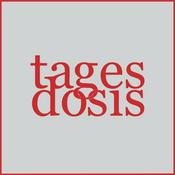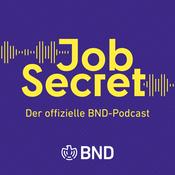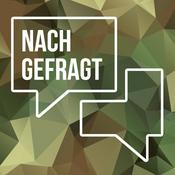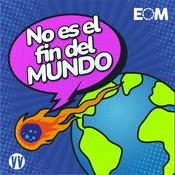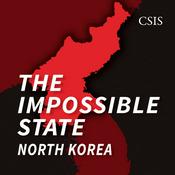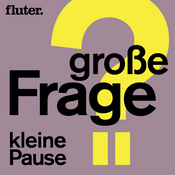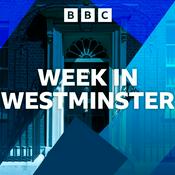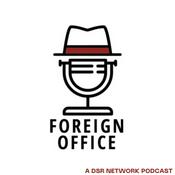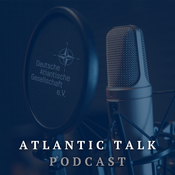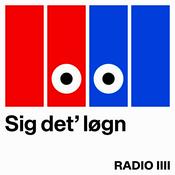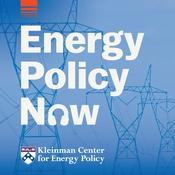115 Episoden

Who Can the President Fire?
16.12.2025 | 27 Min.
2025. The president fires an FTC commissioner before her term is up. The statute says he can’t without cause. He does it anyway. Now the Supreme Court has to decide whether ninety years of precedent was real law, or a bluff. Act I. The Wager[SFX: casino room, cards dealt, chips stacked, ice clinking in glasses]Players stare at each other across a poker table. Four cards are up. One card is face down. The last card decides everything, but nobody gets to see it until somebody commits.You can stare at the felt and pretend time is on your side. But the cost of waiting goes up anyway. You have to put in a bet to keep playing, and that bet keeps getting bigger. The pot grows. The pressure rises. Sooner or later, you have to act with incomplete information.New York City. Late Spring, 1789.George Washington took the oath on April 30. He is the first President of the United States. He has duties. He has no government.No State Department. No Treasury. No War Department. No one to answer a foreign minister or respond to a crisis. The executive branch exists on paper. In reality, it is one man in a rented house with a small staff and a pile of unanswered letters.The Constitution is eight months old. The ink is barely dry. And the world is not waiting.The British still occupy forts on American soil. Forts they agreed to vacate six years ago. Native attacks keep coming from those regions. Plenty of Americans suspect the British, but Washington has no department to respond with.Spain has closed the Mississippi River to American trade. Western settlers are talking about leaving the union. Diplomacy might help. Threats might help. But there is no one to conduct diplomacy. The president cannot do everything himself.American merchant ships are being seized in the Mediterranean. Algiers declared war on the United States four years ago. Sailors are chained in North African prisons, waiting for a ransom that cannot come because we have no Treasury and no Navy.The pot is already enormous. The blinds are rising. And Congress has a problem.The Constitution gives the president the power to appoint officers “by and with the advice and consent of the Senate.”It says nothing about firing them.Nothing.That silence is not calm. It’s cards sliding out. Sideways glances. Men looking across the table, trying to decide what the other man is holding.Sixty-five men crowd into Federal Hall on Wall Street. A repurposed city building that still smells like fresh paint. May turns to June. The weather thickens. No ventilation worth mentioning. Wool coats. Wigs. Windows that don’t open properly. Paper everywhere. Quills scratching. Men sweating through their shirts while arguing about the shape of executive power.They have to build a working government, but the game is already underway. The cards are on the felt. The pot is growing. And they’re still arguing over who gets to deal, who sets the rules, and who can push a man out of his seat.The question before the House is simple to ask and impossible to answer:Who can fire a cabinet secretary?James Madison rises to make a motion.He is thirty-eight years old. A hundred forty pounds soaking wet. He speaks so softly that reporters lean forward to hear him. He is brilliant, but he has never seen combat. He has never led troops. He spent the Revolution in the Virginia legislature, arguing about paper while other men bled.But Madison wrote the Constitution. He wrote most of The Federalist Papers defending it. He has thought more carefully about the structure of American government than anyone alive. When Madison speaks, the room listens.His motion concerns the Department of Foreign Affairs. A department that does not yet exist. A secretary who has not been named. He is writing the job description for a position that is still an idea on paper.Madison proposes one line:He says that the secretary shall be “appointed by the president, by and with the advice and consent of the Senate; and to be removable by the president.”Four words. Nine syllables. “Removable by the president.”The room erupts in disagreement.They can see the future in that sentence. A future president. A future fight. A future Congress trying to bind a president’s hands. They are not arguing about today. They are arguing about every president and every Congress that will ever follow.And they are terrified. But not of the same thing.To understand why the room erupts, you have to understand the ghost in it. That ghost is King George III. Theodorick Bland commanded cavalry in the Revolution. James Jackson of Georgia fought at Cowpens, Augusta, Savannah. Hand to hand when it came to that. Jackson fought twenty-three duels in his lifetime. He settled disagreements with pistols. When he stood up to speak, men listened because they knew what he was capable of.Elbridge Gerry was asleep at the Menotomy Tavern on the night of April 18, 1775. The night Paul Revere rode. British troops marched past his window toward Concord. The weapons they were marching to seize were weapons Gerry had put there. His roommate during the siege of Boston was Joseph Warren. Warren died at Bunker Hill with a British bullet in his skull.On and on. The room was full of men who bled for independence. They sent their sons to bleed. They watched friends die at Brandywine, at Germantown, at the frozen hell of Valley Forge.The Declaration of Independence was thirteen years old. It was a list of crimes committed by a king who answered to no one. These men had signed it. Some had nearly died for it.Now, James Madison, who spent the war arguing about paper, stands before them and proposes giving one man the power to fire anyone in the executive branch.To some of them, it sounds like the first step toward a throne.Underneath that knife’s edge urgency, they are dueling with words while playing this game of American poker. Uncertainty. Ambiguity. They’re all fearful, but not of the same thing. One man hears “removable by the president” and sees a king. Total loyalty. Total control. Every officer knowing he serves at the president’s pleasure. Every officer afraid to disagree. William Loughton Smith of South Carolina places his bet here. He points to the Constitution: the only removal it mentions is impeachment. If you start inventing powers out of silence, you are training future presidents to do the same.Theodorick Bland of Virginia throws in chips next. He hears “removable by the president” and sees the Senate being erased. The Constitution says the president appoints “by and with the advice and consent of the Senate.” The Senate has a role. Would you let a man hire but not fire? Strip the Senate of removal, and you strip the bridle from the horse.Roger Sherman of Connecticut adds to the pot. He hears “removable by the president” and sees chaos. Drift. Officers who answer to no one because no one has clear authority. He says Congress creates these offices, Congress sets the terms, Congress can decide. The Constitution doesn’t give removal power to anyone specifically. So Congress fills the gap.And then there is Madison.Madison has watched legislatures become tyrants.State assemblies under the Articles of Confederation printed worthless money. Exposed private contracts to public violation. Trampled the rights of minorities, religious dissenters, anyone without the votes to protect themselves. In Rhode Island, the legislature printed currency to pay off debts, and the creditors fled the state.Kings were dangerous. Madison knows that. But legislatures were also dangerous. They claimed to speak for the people. They wrapped their tyranny in democratic legitimacy. And they could do it faster than any king because they did not have to pretend to be anything other than the majority.Madison fears Congress more than he fears the president.He could not foresee a Congress that would voluntarily surrender its power. A Congress that would create agencies to avoid making hard choices. A Congress that would build a government designed to answer to no one.He places a large wager. Madison bets on a weak executive fighting a strong legislature. One man against an assembly. The president needs defensive weapons just to survive. If the president cannot remove officers who defy him, you have no accountability. You get paralysis. You get officers who answer to no one. Not to the president, who cannot fire them. Not to the people, who cannot reach them.Madison says it plainly: “If any power whatsoever is in its nature executive, it is the power of appointing, overseeing, and controlling those who execute the laws.”Article II vests the executive power in the president. Not some of it. All of it. The Senate’s role in appointments is an exception, spelled out explicitly. Removal is not spelled out as an exception. Therefore, removal belongs to the president.The room considers the wager. Each man sees a different future. A king. A runaway Senate. A paralyzed executive. A tyrannical Congress. They are reading each other across the table, trying to guess which fear is the right one, knowing they cannot wait for certainty.They look at Madison’s bet. Call, or fold.The British are not leaving those forts. Spain is not opening the Mississippi. American sailors are not freeing themselves from Algiers. Foreign ministers are waiting for someone to talk to. Crises do not pause for constitutional debate.And the pressure. The government has to start. Someone has to be in charge. Someone has to be able to be fired for failing.Then, a breakthrough. A congressman trying to get the room to move on changes the language. The final bill doesn’t say the president “has” the power to remove. It does not say Congress “grants” the power to remove. It says that when a secretary “shall be removed,” certain things happen.The House votes. Madison’s side wins, but there is no consensus. The Senate splits exactly in half. Vice President John Adams casts the tie-breaking vote. The president will have the power to remove officers.They sidestepped the decision. In the end, nobody had to show their cards. The vote passed. The government started. Washington got his departments. The union held. Madison’s big wager was still on the table, waiting for the other players to call the bet.Madison’s wager was a weak executive fighting a strong legislature.He couldn’t imagine a world where Congress would want the president to be strong and unaccountable. Where Congress would lay down and give away power, and presidents would take it. Where the real threat was not a king or a legislature but a machine that ran itself, beyond the reach of elections.The cards stayed down in 1789.But then, one hundred forty-four years later, someone finally called the bet.Act II. The CallOne hundred forty-four years passed. Players left and rejoined the table. The republic grew. The question slept.Then, President Franklin D. Roosevelt called Madison’s wager.Washington, D.C., Summer, 1933. The Great Depression is strangling America. Twenty-five percent unemployment. Thirteen million people are out of work. Banks have failed by the thousands. Farmers watch their land blow away in dust storms. Families lose homes. Children go hungry.Roosevelt has been president for five months. He came to Washington with a mandate. Fix it. Whatever it takes. His New Deal is a whirlwind of agencies, programs, regulations. The federal government is expanding faster than at any time since the Civil War.The president has a problem. His name is William Humphrey.Humphrey is a commissioner on the Federal Trade Commission. He is seventy-one years old. A conservative Republican. A man who believes government should leave business alone.The FTC is supposed to protect consumers from unfair business practices. Under Humphrey, it has become a graveyard for investigations. Cases against mattress companies. Shoe manufacturers. Soap makers. Humphrey votes to dismiss them. One after another. He gives speeches calling the commission an instrument of oppression against American enterprise.Roosevelt needs the FTC to help implement the New Deal. Humphrey is blocking him.In July, Humphrey hears a rumor. The president wants him gone.He writes to Roosevelt directly. A desperate letter. Information comes to me that you are going to ask for my resignation, he writes. For what reason, I do not know. He asks for a meeting. After more than forty years of public service, being forced out would greatly injure his reputation. Humphrey believes he is doing the right thing. Roosevelt waits less than a week. Then he sends his reply.The letter is polite. But it is not subtle. You will, I know, realize that I do not feel that your mind and my mind go along together, Roosevelt writes. On the policies. On the administration of the commission. Frankly, I think it is best for the people of this country that I should have full confidence.He asks for Humphrey’s resignation.Roosevelt. Charming. Ruthless. Certain.Humphrey refuses.For two more months, they exchange letters. Roosevelt asks again. Humphrey declines again. In October, Roosevelt stops asking.Effective as of this date, he writes on October 7, 1933, you are hereby removed from the office of Commissioner of the Federal Trade Commission.Twelve words. No cause given. No charges filed. Just removed.Now, on to the law. A commissioner may be removed only for inefficiency, neglect of duty, or malfeasance in office. Roosevelt did not claim any of these. He simply said their minds did not go along together.Policy disagreement is not neglect of duty. Voting against investigations is not malfeasance. Roosevelt was firing Humphrey because Humphrey was in his way.Humphrey does not go quietly.He writes to his fellow commissioners. He tells them he is still a member of the FTC. Ready and willing to exercise the powers of his office. He shows up at the next meeting. He sends a letter to the man Roosevelt nominated to replace him that there is no vacancy.Humphrey keeps coming to work. Every day. The FTC stops paying him, but he comes anyway.He files a lawsuit. He wants his job back. He wants his salary. And he wants the Supreme Court to decide whether the President of the United States can fire him.Then, on February 14, 1934, five months after his firing, William Humphrey dies. A stroke. He was seventy-one.But the lawsuit doesn’t die with him.Samuel Rathbun, his executor and the person handling his estate, keeps the case alive. He sues for back pay. For the salary the government owed Humphrey between his firing and his death.The real question is bigger than back pay. The real question is whether Roosevelt had the constitutional authority to fire him at all.This is where Madison’s wager returns to the table.Nine years earlier, in 1926, the Supreme Court had seemed to settle the matter. President Woodrow Wilson fired a Portland postmaster. The postmaster sued for his salary. The case went all the way up.Chief Justice William Howard Taft wrote the opinion. Taft was the only man in American history to serve as both president and Chief Justice. He knew something about executive power.Taft ruled overwhelmingly for the president. The Constitution vests all executive power in the president, he wrote. The power to remove is a natural part of the power to appoint. If the president cannot fire his subordinates, he cannot ensure the laws are faithfully executed.The opinion ran over seventy pages. It reached back to Madison. To the Decision of 1789. Taft declared that Madison had won. The president possesses unlimited power to remove executive officers.So when Humphrey’s case reached the Supreme Court in 1935, Roosevelt’s lawyers were confident. The president would win. End of story.Roosevelt had called Madison’s bet. Show your cards.The Court refused to show. They had one play left.Act III. The Bluff The Court heard arguments on May 1, 1935. Twenty-six days later, they announced their decision.May 27, 1935. It would become known as Black Monday. On that single day, the Supreme Court issued three unanimous decisions against Roosevelt. Justice George Sutherland wrote the opinion. Sutherland was one of the Four Horsemen, the conservative bloc trying to dismantle Roosevelt piece by piece. These justices viewed the New Deal as straight-up socialism wrapped in American flags. Sutherland did something clever. He didn’t overturn Taft’s postmaster decision. He changed the rules mid-game.A postmaster, Sutherland wrote, is a purely executive officer. He carries out the president’s orders. He belongs to the president. The president can fire him.But the Federal Trade Commission is different. Congress built it to stand apart. Not partisan. Not an arm of the president. Its commissioners write rules and judge disputes inside their own domain. They do not serve the president. They serve the law.Congress built an agency inside the executive, then tried to keep the president’s hands off its leaders. Sutherland had invented a new category. Officers who work in the executive branch but do not answer to the executive. Creatures of Congress, not creatures of the president.The Constitution, Sutherland wrote, does not give the president unlimited power of removal over such officers. They lead independent agencies.Roosevelt lost. Humphrey’s estate got its back pay. The court said Presidents can fire purely executive officers at will, but that didn’t apply to everyone in the executive branch. So…where does the executive end and these independent positions begin?The Court didn’t say. It never identified which jobs were executive officers and which were not. It left, in its own words, a field of doubt for future cases.Roosevelt was furious. Black Monday felt like a personal attack. The decisions helped trigger his attempt to pack the Supreme Court with additional justices. That plan failed. But the battle between Roosevelt and the Court reshaped American government.As for the wager Madison made in 1789? Still on the table.Humphrey’s case created a new category of government. Independent agencies. Leaders protected from presidential accountability. For ninety years, that rule held.It was a bluff dressed up as constitutional law. The question was never whether the president had the power to fire executive officers. The question was whether Congress could create officers who weren’t executive at all.Madison never imagined such a thing. Neither did his opponents. In 1789, everyone assumed the executive branch belonged to the president. They fought about removal inside the executive branch because they agreed on that much.The Supreme Court’s fight against FDR broke that assumption. A conservative court created the modern independent regulatory state. This decision became the same movement conservatives have been trying to dismantle for fifty years. It wasn’t some master plan; it was a grenade aimed at FDR that backfired spectacularly over time. Conservatives built the administrative state to block liberals. Liberals expanded it for social good. And now everyone’s mad because it’s this unaccountable behemoth.Roosevelt called. The Court bluffed. They changed the rules mid-hand and walked away from the table.It worked. For ninety years, no one challenged the bluff.Act IV. The RiverThe river card is still face down. Four cards up. One card hidden. That last card decides everything. This week, the river card is a Supreme Court case. Trump v. Slaughter.This game has been running for two hundred thirty-seven years.In 1789, Madison placed his wager. The House split. The Senate split. The last card stayed face down.In 1933, Roosevelt called the bet. He fired Humphrey and dared the Court to stop him.Then a new player sat down.The Four Horsemen looked at Madison’s bet, looked at Roosevelt’s call, and said: We’re playing a different game now. It was a bluff. But it was also a new table. And for ninety years, everyone played by the new rules.Until now.The case is Trump v. Slaughter. President Trump fired the leaders of independent agencies and said the Constitution gave him the power to do it. The agencies sued. The lower courts said he couldn’t. The Supreme Court agreed to decide.For the first time in ninety years, someone is calling the bluff. Just like FDR in 1933. But it’s more than that. Someone is saying: We’re going back to the original table. Madison’s table. The one where the cards have been face down since 1789.The river card is about to flip.Here is what we know: The Constitution says nothing about removal. Madison thought the president needed that power to survive. Chief Justice Taft agreed. The Four Horsemen didn’t. Nine decades of precedent rest on a Chief Justice’s attack on FDR.Here is what we don’t know: What the original cards actually say.Madison made his wager in 1789. He bet that Congress was the threat. He may have been right about the Constitution. He may have been wrong about the future. He could not foresee a Congress that would voluntarily surrender its power. A Congress that would build agencies to avoid making hard decisions. A Congress that would create a government that answers to no one.In 1789, the river card stayed down. Two hundred thirty-seven years later, the Supreme Court is going to flip it. Will the Court finally answer Madison’s question? Or will they find another way to leave the cards face down? Whatever they decide, the crux of this matter isn’t Donald Trump. Not Franklin Roosevelt. It’s about every future president. The same Court that just gave presidents near-blanket immunity is about to hand them the power to fire any agency head at will. Arming the next Democratic president with the exact same weapons.One day soon enough, a progressive in the Oval Office will wake up, look at the FTC, the SEC, the Fed, the NLRB, and say, “Your mind and my mind do not go along together.”It comes down to whether the Constitution means what it says. Article II. “Executive Power shall be vested in a President of the United States of America.”Who can the President fire?Let’s see that river card!May God bless the United States of America.Music from Epidemic SoundArtist: Fabian TellSong: Gilly Get full access to I Believe at joelkdouglas.substack.com/subscribe

Who Gave You Permission to Touch Our Sky?
09.12.2025 | 26 Min.
Act I. The Sky WarSFX: Thunder rolling in the distance. A slow rotor hum. Laos. March 20th, 1967.A C-130 Hercules lifts off from Udon Royal Thai Air Force Base just after sunset. The crew has the cargo bay loaded with canisters. Not bombs, not supplies; canisters of silver iodide mixed with lead iodide and acetone. Command briefed the crew separately from every other unit on base. The flight plan logs say the crew's mission is “weather reconnaissance.”Their actual mission: to make it rain over the Ho Chi Minh Trail.Not to predict rain. Not to wait for rain. To make rain. To pull water from clouds that weren’t ready to give it up yet. We weren’t trying to win the weather. We were trying to weaponize it and choke off the supplies that kept the war alive in the South.This is Operation Popeye. And for the next five years, it will remain the most classified weather experiment in American military history.SFX: C-130 rotor hum. Wyatt: “Hell, son, we weren’t tryin’ to predict the weather. We were tryin’ to break it.”The problem started with a road. Except it wasn’t really a road. A network of trails, footpaths, rivers, tunnels, and jungle passages ran from North Vietnam through Laos and Cambodia into South Vietnam. The Americans called it the Ho Chi Minh Trail. The North Vietnamese called it the Truong Son Road. And no matter what the Air Force threw at it, the damn thing wouldn’t die.We tried bombing it, thousands of sorties under Operation Steel Tiger. The jungle swallowed the craters. We tried napalm. The canopy grew so thick that the fire barely reached the ground. We tried defoliants, including Agent Orange by the truckload, and managed to strip some foliage, but the trail just shifted a hundred yards east or west, braiding through the forest like a living thing.We even considered using nuclear weapons, but decided they wouldn’t end the war and would only invite the enemy to use them back. The North Vietnamese moved at night. They built the trail in sections. Different units maintained each section. They camouflaged each one during the day with cut branches and woven bamboo mats. When American reconnaissance planes flew over, they saw nothing. When the bombs came, the crews scattered into prepared bunkers, waited out the strike, then came back out and filled in the holes.By 1966, as many as 20,000 North Vietnamese troops moved down the trail every month, along with enough supplies to sustain the Viet Cong insurgency in the South. Trucks rolled south. Bicycles carried 500-pound loads. Porters balanced bamboo poles across their shoulders. The trail functioned as the circulatory system of the war. Cut it, and you would bleed the enemy dry. But nothing we tried would work.Bombs couldn’t stop the trail. Fire couldn’t stop it. But water could.During monsoon season, May through October, the trails turned to soup. Trucks bogged down axle-deep in mud. Bicycles were useless. Porters slogged through conditions that turned a day’s march into three days. The North Vietnamese themselves estimated that supply capacity dropped by sixty percent during heavy rains.So someone at the Pentagon had an idea. What if we could extend the monsoon?Aida: “Cloud seeding had existed since 1946. Vincent Schaefer at General Electric discovered that dry ice dropped into supercooled clouds could trigger ice crystal formation. Essentially, you could start the rain process manually. By the 1960s, people used it commercially. Ski resorts, farmers, even some cities experimented with it.”But this was different. Farmers weren’t trying to coax an extra inch of rain onto their fields. The United States military wanted to manipulate weather patterns over a foreign country to gain a tactical advantage in a war.The Pentagon classified the operation at the highest level from the start. So secret the program didn’t officially exist, and only a select few even knew about it. The Joint Chiefs approved it in 1966. Secretary of Defense Robert McNamara signed off. President Johnson knew. But almost no one else did. Someone told the crews that the missions were “weather modification experiments” and that the details exceeded their clearance level. The planes, C-130s and F-4 Phantoms modified with cloud-seeding equipment, flew out of bases in Thailand.Crews ignited the silver iodide canisters at altitude. The canisters released microscopic particles into the clouds. These particles acted like ice crystals. In the right conditions, with supercooled clouds that had plenty of moisture, the crystals would grow, become heavy, and fall as rain. The theory sounded solid. The question remained whether it would work at scale.The first test runs happened over the Laotian panhandle in March 1967. Someone gave the operations pastoral codenames: “Motorpool,” “Intermediary,” “Compatriot.” Publicly, if anyone asked, these were agricultural flights. Crop dusting.And it worked. Quietly, invisibly, and just enough to tempt us into thinking we could control the sky. We increased rainfall in the targeted areas by around twenty-five to thirty percent. Roads that should have dried out stayed muddy. River crossings that should have become fordable stayed swollen. Entire sections of the trail turned into bogs.Wyatt: “We’d fly the pattern they gave us, release what they told us to release. Sometimes a few hours later you’d see weather building that didn’t make sense for the conditions. Made you wonder what the hell was in those canisters.”We expanded the operation. By 1968, Popeye missions flew regularly during the rainy season, focusing on the sections of the trail in Laos and the demilitarized zone. Command mixed the sorties in with regular bombing runs so they wouldn’t stand out. The pilots treated it like any other mission: brief, fly, return, debrief.If cloud seeding could have put the entire Ho Chi Minh Trail underwater for months, cut those 20,000 troops down to zero, and stopped the supply flow completely, we would have seeded clouds until the whole jungle was mud. That was the job. That could have meant winning.But it didn’t do that.It worked, but not well enough. Twenty-five percent more rainfall meant muddier roads and slower convoys. It meant frustrating the enemy. It meant some marginal degradation of their logistics. But it didn’t cut the trail. It didn’t stop the war. It didn’t change the outcome.What it did do was teach the wrong lesson. Not that the tool was weak, but that the temptation was strong.If the United States could make it rain over Laos, even imperfectly, then the Soviet Union could make it rain over West Germany. China could trigger droughts in Taiwan. Weather could become an instrument of policy. Did we want that? If we can turn weather into strategy, then weather becomes politics. SFX: Thunder closer now. Rain beginning to fall.Congress didn’t learn about Operation Popeye until 1971, when investigative journalist Jack Anderson broke the story. Anderson had a reputation as a muckraker, but the hearings that followed made people uncomfortable. Senators asked military officials to explain how the program had been approved and executed in secret for years.The answer always took some version of the same form: “It was necessary. It was effective. It was war.”Except it wasn’t effective enough. We’d spent five years secretly weaponizing the sky for results that barely moved the needle. We’d opened Pandora’s box on weather modification for marginal tactical gains.By 1972, the Pentagon shut down Popeye. By 1977, the United Nations drafted and ratified the Environmental Modification Convention which prohibited military or hostile use of environmental modification techniques. Forty-eight nations signed it. The United States signed first. A done deal, right? No more cloud seeding.But here’s where the story turns.Let’s go back to 1915 and a man who claimed he could make it rain. And it worked!Act II. The RainmakerSan Diego. December 13th, 1915.A man stands before the city council. He’s forty years old, pale-skinned, blue-eyed, dressed in a dark suit. His name is Charles Mallory Hatfield. He sells sewing machines for the New Home Sewing Machine Company. But that’s not why he’s here.He’s here because San Diego is dying of thirst.The Morena Reservoir is only one-third full. The city’s population had doubled in a decade. The Panama-California Exposition is entering its second year, and civic boosters worry the drought will scare off tourists. A group called the San Diego Wide Awake Improvement Club has been pressuring the council to do something. Anything.And so Charles Hatfield makes them an offer.He will fill the Morena Reservoir to overflowing. If he fails, they owe him nothing. If he succeeds, they pay him ten thousand dollars.Councilman Walter Moore explains the logic: “If he fills Morena, he will have put 10 billion gallons into it, which would cost the city one tenth of a cent per thousand gallons; if he fails to fulfill his contract, the city isn’t out anything. It’s heads the city wins, tails Hatfield loses.” The council votes four to one. Only Councilman Herbert Fay objects, calling it “rank foolishness.”No one draws up a written contract. A handshake is enough.SFX: Footsteps on gravel. Wind picking up.Hatfield wasn’t a con man. Not exactly.He was born in Fort Scott, Kansas in 1875. His father moved the family to Southern California in 1886. Although a salesman by trade, Hatfield was no smooth-talking huckster. He had a polite, homespun manner.As a young man, he was inspired by the way a boiling kettle attracted the water vapour rising from an adjacent, steaming pan on his mother’s stove. That got him thinking. By 1902, he had created a mixture of 23 chemicals in tanks that he claimed attracted rain. One news editor remarked that the chemicals smelled so bad that the sky rained in self-defense.But it seemed to work. Hatfield claimed at least 500 successes. Was he a fraud? Maybe. Later commentators would say his success was mainly weather prediction, detailed study of rainfall statistics, and an innate sense of timing. He picked periods where there was a high probability of rain anyway. Or maybe he knew something we still don’t understand.Either way, on January 1st, 1916, Charles and his brother built a twenty-foot wooden tower beside Lake Morena, sixty miles east of San Diego, three thousand feet up in the mountains. They set iron pans on the platform at the top, poured in Hatfield’s secret mixture, and lit the fires.The chemicals began to evaporate into the sky.On January 5, 1916, it started to rain. The rain grew gradually heavier day by day. At first, San Diego celebrated. The reservoirs were filling. The drought was breaking. The Rainmaker had delivered.Then the rain kept coming.By January 17, chaos ensued. Runoff filled empty gullies. The San Diego River overflowed, flooded Old Town and Mission Valley, and swept roads, railroads, and bridges away. At one point, four feet of water rushed down Broadway. The Hatfield brothers, up on their mountain, couldn’t see what was happening below. No phone. Roads washed out. They just kept feeding chemicals into the sky.The rain let up for a few days, and then it came back.By January 27th, conditions were epic. In South Bay, the water in the Sweetwater reservoir overflowed the dam and tore out a fifty-foot chunk on one end. Then the Lower Otay Dam broke. A 40-foot wall of water surged into the valley below. The flood destroyed the entire valley, towns gone, farms erased. No one knows for sure how many died. Some say twenty; others, sixty. Many of the victims were Japanese farmers who lived in the valleys. These farmers were mostly isolated from the general population. The morning after the dam broke, the city treasurer went to the mouth of the Otay River. Out on the water, he saw many small boats; the Japanese colony, searching for their dead.By the time the rain stopped in San Diego County, nearly 30 inches had fallen in a month. January 1916 is still the wettest period in San Diego’s recorded history. SFX: Footsteps. Wind.Up on the mountain, Charles Hatfield saw Morena Reservoir full of water and concluded he had fulfilled his contract. He and his brother walked the sixty miles back to San Diego to collect his ten thousand dollars.The devastation must have surprised them. Angry, swollen rivers and streams. Houses swept away. People lost. When Hatfield arrived, the city attorney asked: “If Hatfield were to get credit for the rain, would he accept liability for the damage?” City official Terence Cosgrove refused to pay Hatfield because that would make San Diego liable for the damages in the eyes of the courts. Hatfield sued. The case dragged on. A judge ruled that the flood was “an act of God.” When it came time to assign responsibility, the courts said: this wasn’t human action. The ruling absolved the city of liability and left Hatfield with no compensation. In the end, the city got to have it both ways. They hired a rainmaker, got rain, disclaimed responsibility, and called the outcome divine.Hatfield never collected his ten thousand dollars. He went back to work as a sewing machine salesman. His wife, Mable, divorced him in 1931. So…did Hatfield make it rain? Scientists say San Diego was likely hit by two atmospheric rivers that month. The same storms drowned the entire Pacific coast.Maybe Hatfield was a fraud who got lucky. Maybe he was a skilled forecaster who knew how to time his arrival. Maybe he actually did something. We don’t know.The ambiguity is the crux. Because now we have two stories, and neither gives us a clean answer.In Vietnam, we had a tool we knew worked. Cloud seeding increased rainfall by twenty-five percent. Measurable. Real. But the results were mediocre. Roads got muddier. The war continued. In San Diego, we had a tool that might have been a scam. But the results were decisive. Thirty inches in a month. Dams broke. People died.Act III. The BridgeThis isn’t about rain or climate change.This is about what we spend the people’s money on. What government is actually for.America has six national goals. Right there, hiding in plain sight in the Constitution. Maintain Union. Establish Justice. Insure domestic Tranquility. Provide for the common Defence. Promote the general Welfare. Secure Liberty.Everything government does should serve at least one of those. If it doesn’t, we shouldn’t be doing it.If we fund geoengineering, cloud seeding, spraying the stratosphere, whatever comes next…what goal does it serve?Here’s a story about people who asked that question. And got laughed at for it.Tennessee. March 2024.A state legislature debates Senate Bill 2691. The bill would ban, and this is the key line, ‘the intentional injection, release, or dispersion… into the atmosphere with the express purpose of affecting temperature, weather, or the intensity of the sunlight.’The national press picks it up. Headlines frame it as a “chemtrail ban.” The jokes write themselves. And the laughter! Those white lines behind jets are condensation, not mind control. Don’t they know the difference between science and conspiracy theory?The bill passes anyway. Governor Bill Lee signs it into law.The headlines mocked Tennessee as backward, another story of people who don’t understand science.Except…The actual bill doesn’t mention chemtrails. It doesn’t mention mind control or poison or any of the things some assume these people believe. It bans the intentional release of substances into the atmosphere to modify temperature or weather.That’s not crazy. That’s literally what geoengineering is.The scientists, the policy papers, the UN reports all describe doing exactly what Tennessee just banned. Spraying aerosols into the stratosphere. Seeding clouds to reflect sunlight. Releasing particles to cool the planet.Tennessee didn’t ban a conspiracy theory. They banned a technology that doesn’t quite exist yet, but almost certainly will.And they did it before anyone asked their permission to use it.Some of the people who support this bill might believe some crazy things. They might think the government is already spraying chemicals. They probably got the science wrong in a dozen ways.But they got something right that the experts missed entirely.They asked: Who decides?Who decides whether we spray the stratosphere? Who decides whether we seed the clouds over Tennessee, or Wyoming, or anywhere? Who votes on that? What legislature authorizes it? What constitutional provision permits it?The answer, right now, is: nobody. No vote. No debate. Just experts who think it might be necessary, and politicians who don’t want to say no, and everyone assumes someone else will figure out the governance later.That’s how Operation Popeye happened. Secret flights, classified programs, five years of weather modification before Congress even knew.That’s how Hatfield happened. A handshake deal, no written contract, and when the dam broke, the courts called it God.The chemtrail people may be wrong about the facts. But they’re not wrong about the instinct.Someone is going to touch their sky. Someone is going to spray, seed, or modify something, and nobody is going to ask them first. The decision will be made in a conference room somewhere, by people with credentials and good intentions, who genuinely believe they’re saving the world.And by the time Tennessee notices, it’ll be too late to stop.So they passed a law. A silly law that the experts laugh at.But it’s also a law that says: you need our permission to modify our weather.Let’s go back to the six goals.Maintain Union. Establish Justice. Insure domestic Tranquility. Provide for the common Defence. Promote the general Welfare. Secure Liberty—for ourselves and our posterity.If geoengineering serves one of those, then let’s have the debate. Let’s argue about which one. Let’s pass broadly supported bipartisan legislation that says “addressing climate change is part of the general Welfare” or “preserving a livable planet is necessary for the common Defence.” Let’s do what the Founders did: state our purpose, argue about it, vote on it, and write it down.But we haven’t done that.We’ve got research, pilot projects, scientists, activists, and endless policy papers.What we don’t have is a democratic Republic’s decision. A vote. A statement of purpose that says: this is what we’re doing, and this is why, and this is who authorized it.The conspiracy theory chemtrail people, wrong about everything, are the only ones who noticed that was missing. It’s an answer to a question: Is preserving a livable climate a national goal?Not “should we do something about climate change?” That’s too vague. Let’s be specific. Should we as a nation say that climate change is one of the purposes of American government, alongside justice and liberty and defense and welfare?Maybe. Maybe not. We haven’t asked.If the answer is yes, that preserving a livable climate is a national goal, then we can finally have a real debate about means. About what tools serve that goal. About whether geoengineering is a bridge to somewhere or a bridge to nowhere.If the answer is no, that we cannot agree this is a government purpose, then we have learned something important too. We have learned we do not have consensus. We have learned that any geoengineering program is illegitimate, because “We, the People” never agreed to it.Either way, the question has to be asked out loud, in public, by a self-governing people: Who gave you permission to touch our sky?May God bless the United States of America. Get full access to I Believe at joelkdouglas.substack.com/subscribe

Should Every Generation be Richer than their Parents?
02.12.2025 | 30 Min.
Act I. The Golden Handcuffs(SFX: Blizzard wind.)January 1914. Highland Park, Michigan. Six degrees above zero.Ten thousand men press against the iron gates of the Ford Motor Company. Wool coats thin as paper. Broken boots stamping frozen mud. The guards inside are terrified. The mob is too large, so they turn the fire hoses on them. The water hits. Soaks through. Freezes instantly to ice on their coats.The men don’t leave. They stand there, shivering, because a rumor has spread through the tenements of Detroit. A rumor that sounds like salvation:Henry Ford is going to pay five dollars a day.Understand what this means. At this moment in history, a factory man earns two dollars and thirty cents. He sleeps in a boarding house. Eats cabbage. Works ten hours until his back locks, then drinks away the pain at the saloon.Ford is offering double for eight hours of work. An invitation for a laborer to live like a human being.The men freezing at the gate think Henry Ford is their savior. They don’t know the whole truth. Ford didn’t actually raise wages to five dollars. Base pay stayed at two-thirty-four. The rest, two dollars and sixty-six cents, he classified as “profit sharing.”To get the profits, you had to pass inspection.Ford created something called the Sociological Department. This wasn’t just Human Resources. This was a private intelligence agency. He hired 150 investigators. Gave them badges. Cars. And a mandate:Go to the homes.Here’s how it worked:You finish your shift. Go home. Sit down for dinner.A knock at the door. A man in a suit walks in, doesn’t ask permission. Opens your cupboards. Checks your bankbook. Questions your neighbors.Does he drink? Is the house clean? Is he living with a woman who isn’t his wife?If the investigator didn’t like what he saw, if your wife was working, if you bought a luxury before you bought property, he marked a red check on his clipboard. It tracked half the workforce. It pushed them into ‘Americanization’ classes to scrub away their accents and teach them how to be proper, obedient citizens.Next payday? Two-thirty-four. The “profits” withheld. You’re on probation. Fix your life, or you’re fired.Now imagine you’re one of those men.You’ve been standing at the gate for three hours. Your coat is frozen stiff. Your children are hungry. Your wife is coughing blood because the tenement has no heat.Ford’s man finally opens the gate. He hands you the paperwork. He explains the terms.You read it. You understand it. You know what you’re trading. And you sign.Because what kind of person wouldn’t? You resent the privacy invasion, but your children need a warm house. Your wife needs a doctor. You need to stop drinking yourself to death just to get through the week.Ford is offering you a way out, and all it costs is permission. Permission for a stranger to walk through your door. Permission to judge how you live.That’s the trade. Autonomy for comfort. Privacy for security.And you take it. Who among us wouldn’t? Because we love our children more than we love our pride. We make the deal.What they thought would make their children richer came with a cost they didn’t see yet.The men took the deal. They stopped drinking. Cleaned their houses. Learned English. Bought the Model T. They became “materially better.” They had heat. Meat on the table. Shiny shoes.We judge prosperity in income, consumption, and lifespan. By every measure, Ford’s workers won.Their children grew up in warm houses. Went to school with full bellies. Had shoes without holes.The workers looked at their fathers, men who died at fifty with nothing, and they knew they’d made the right choice. They’d bought their children a better life.Ford’s productivity went up too, just like he planned. In 1913, Ford had to hire 52,000 men just to keep 14,000 on the floor. Turnover was running at 370% a year. Training a new man cost the company roughly $100 in today’s money every time someone quit after a week. The $5 day, even with the strings attached, was still cheaper than that chaos. And it worked.Absenteeism dropped. Turnover collapsed. It used to be 370% annually, but fell to 16%. Workers showed up sober. Worked faster. Made fewer mistakes.Productivity went up. Way up. In 1914, it took 12 hours and 8 minutes to assemble a Model T. By 1920? One hour and 33 minutes.Ford didn’t pay five dollars a day out of charity. He paid it because it was cheaper than chaos. A sober, stable, surveilled workforce was more profitable than a desperate, drunk, transient one. He cut turnover costs and saved $100M annually in today’s dollars. Profits doubled from 1914 to 1916. Every boss in America took notes. They called it ‘Welfare Capitalism.’ It sounded generous. It was actually a leash. The inspections weren’t about morality. They were about profitability. Ford’s workers paid for their own compliance. He didn’t force them. He bought them. He made submission profitable.The men took the deal. They quit the saloons. They scrubbed their floors. They opened savings accounts. They learned English in Ford’s mandatory classes. They bought Model Ts on installment, often from the same company that was watching them. Their kids went to school with shoes that didn’t leak.They didn’t clean their houses because he ordered it. They wanted the money. They didn’t stop drinking because he banned it. They couldn’t afford to lose the profit-share. They invited the inspector in because their children were counting on it.Other companies watched the numbers and copied pieces of it. General Electric, International Harvester, and dozens more launched profit-sharing plans. “Welfare capitalism” became the buzzword of the 1920s. An effort to control workers while, at the same time, giving the state no excuse to cross the property line. But once you accept that the price of a good life is constant inspection, you can’t unmake the deal. It becomes normal. The cost of living well. You trade your autonomy for comfort.Ford called this the Five Dollar Day. He called it profit-sharing. We still call it the birth of the Middle Class. We hold the products of the plans in high regard. Profit-sharing bonuses. Retirement plans. Medical services. What Ford proved, accidentally or not, is that he could get a huge chunk of the population to trade a very specific kind of liberty, the privacy in your own home and freedom from moral judgment by your employer, for material goods. And most of us would consider it a bargain.Pensions, profit-sharing, and the company doctor were born inside a surveillance program. In the 1920s, with no regulation, these tools controlled workers. We still call them benefits. We just stopped noticing the handcuffs. Act II. The Fugitive and The TenantHere’s the question that should bother us: Ford’s workers got the money. The cars. The warm houses. Did they actually get richer?To answer that, we need to go back to the old definition of property. Not the modern one, based on the number in your bank account. The old one. The one that defined what it meant to be free before anyone ever heard of an assembly line.Back to a fugitive on the run.1683. London. Past midnight.A man is packing by candlelight. One candle. Any more would draw attention from the street.His name is John Locke. Fifty-one years old. A philosopher, not a soldier. He’s spent his life in libraries, writing treatises on medicine and education that offended no one. But now his hands won’t stop shaking.He’s deciding what to bring. What to leave. What might get him killed if they search his bags.At the bottom of his trunk, wrapped in oilcloth, sits his life’s crown jewel. A manuscript. Two hundred pages arguing that kings rule by consent, not by God. That when a king becomes a tyrant, the people have the right to remove him. By force if necessary.If the King’s men find it, they won’t need a trial. Because King Charles II remembers.Charles was eighteen years old when Parliament put his father on trial. Eighteen when they declared that the people had the right to judge their king. Eighteen when they marched Charles I to a scaffold outside the Banqueting House in Whitehall, made him kneel, and took his head off with an axe while a crowd watched.Charles II spent the next eleven years in exile, begging foreign courts for money. He watched Oliver Cromwell and then Cromwell’s son sit on his family’s throne. He got it back in 1660, but he never forgot what happens when subjects start believing they can say no.So he kept lists. He paid informants. And when a group of rebels plotted to ambush his carriage at a place called Rye House, he didn’t just hunt down the gunmen. He hunted down everyone who’d ever given them ideas.Algernon Sidney. Beheaded. His crime? A manuscript found in his study arguing that people could resist tyrants. The judge declared that “scribbling is treason.”Lord William Russell. Beheaded. He’d spoken too freely about the rights of Parliament.John Locke watched his friends die. And he knew his manuscript was more dangerous than anything Sidney had written. Sidney argued resistance was sometimes justified. Locke was building a philosophical system that made resistance a duty. He was explaining, in precise and careful prose, exactly why Charles I deserved what he got.It wasn’t philosophy. It was sedition. A manual for revolution. Boots on the cobblestones outside. Voices. He doesn’t know if they’re coming for him or just passing by.He wraps the manuscript tighter. Buries it beneath his shirts. And slips out the back door into the English fog.He made it to the coast, probably a southern port. Locke was careful not to leave any records. He crossed the Channel to Holland and surfaced in Amsterdam before settling in Rotterdam.He changed his name. Called himself Dr. van der Linden. Grew a beard. Lived among a community of English exiles who had backed the wrong side and were waiting for the tide to turn.The English crown knew he was there. They pressured the Dutch government to return him. At one point, the threat grew serious enough that Locke went deeper underground. He lived with Quaker families who hid refugees.For six years, he looked over his shoulder. Watched for spies. Corresponded in coded language. He was never quite sure when the knock would come.He kept writing. They never found him. Then, his moment came in 1688.The Glorious Revolution. William of Orange crossed the Channel with a Dutch army. James, Charles’s brother, was now king, and he fled to France without a fight. Suddenly, the man who had been hunted for treason was a prophet.Locke sailed back to England on the same ship as Mary, the new Queen. He published the manuscript. His ideas would long outlive him.In that manuscript, Locke made an argument that seems obvious now but could get you killed then. He said property isn’t just your stuff. Not just your land, your house, your tools.Property is three things: Life, Liberty, and Estate. Your body. Your freedom to make decisions about your own existence. Your possessions.And you can’t separate them.They’re not three choices on a menu. They’re three legs of a single stool. Kick out any one, and the whole thing topples.If you own your labor, you own what that labor produces. You work. You sweat. You get paid. And once you have the money, no one gets to tell you how to spend it. Not a king. Not a lord. Not a bureaucrat. If they can tell you how to spend it, it was never yours. You were just holding it for them.The ideas spread through Europe.A century later, the ideas crossed the Atlantic.The men who wrote the American Constitution didn’t soften Locke. They sharpened him. His manuscript would eventually found America, where we owe allegiance to no King. Yale University calls Locke “an honorary founding father of the United States.”His book became the philosophical basis for the US Constitution. In it, the Fifth Amendment: “No person shall be deprived of life, liberty, or property, without due process of law.”The three-legged stool, written into the supreme law of the land.The Founders understood what Locke understood. The three parts of your property are one. Take away any one leg, and the others collapse. A man who owns his labor but cannot keep what it produces is a slave. A man who has possessions but cannot decide how to use them is a tenant. A man who has freedom but no security isn’t free.So they built protection around all three. The government cannot take your life, your liberty, or your property without due process.But they didn’t anticipate Henry Ford.The Constitution protects you from a government that wants to seize your property. It doesn’t say anything about you handing it over yourself.Fast forward to January 1914. Highland Park, Michigan. Six degrees above zero.Ten thousand men stand at Ford’s gate. Their coats are freezing to their bodies. Their children are hungry. Their wives are sick.Ford’s man opens the gate. Hands them the paperwork. Explains the terms. Keep your house clean. Stay sober. Let us inspect. And we’ll give you a life your father never dreamed of.They read it. They understand it. They know what they’re trading.And they sign.Locke ran from the deal. He chose cold exile and a borrowed name over a comfortable life with strings attached. He kept all three legs of the stool because he understood you can’t sell one without losing the others.The men at Ford’s gate made a different choice. They looked at their hungry children and their sick wives, and they decided that two legs were better than none.They thought they were gaining property. They became servants.When a stranger can walk into your house unannounced, open your cupboards, check your bankbook, question your neighbors, and then decide whether you get paid this week, you are not free.The house might have your name on it. The mortgage might come out of your paycheck. But if your ability to keep paying depends on his approval of how you live, you’re renting your own life.And here’s where the damage spreads.When Ford’s workers traded their autonomy for that five-dollar day, they didn’t just make a choice for themselves. They redefined success for everyone who came after. They taught their children that prosperity means having stuff, even if someone else holds the keys. Some say the American Dream is a measurement. They are often trying to convince you to vote for them. They ask, are you “materially better” than the generation before? They count the square footage. The gadgets. The horsepower. They act like Estate is the only leg of the stool that matters.But Locke, packing by candlelight, running from the King’s men, knew better.He left most of his stuff behind in a room in England. He knew his ability to choose and his voice were his most treasured estate. That brings us to a witness. Someone who looked at this bargain from the outside and saw it for what it was.Act III. The Witness(SFX: Night insects. A low fire crackling.)1688. Michilimackinac. The straits between the Great Lakes.The air smells of pine smoke and lake water. Two men sit on opposite sides of the fire.On the French side: Louis-Armand de Lom d’Arce, Baron de Lahontan, twenty-two years old, lieutenant in the colonial marines. His uniform coat is unbuttoned, the silver gorget at his throat catching the firelight. A pewter cup of brandy rests beside him. He is scribbling notes on whatever scraps of paper he can find, because everything this man across from him says feels like it matters.Across the fire: Kandiaronk, called Adario by the French, called Le Rat for the way he always seems three moves ahead. He is perhaps forty, maybe fifty. No one writes down birth years here. A single eagle feather is tied into his roached hair. Around his neck hangs the wampum collar that marks him as the principal war chief of the Tionontati Petun settled at Michilimackinac. He is smoking a long red-stone pipe, passing it now and then to the young lieutenant who has learned not to cough.He has just pulled off the boldest diplomatic sabotage in the history of New France, and the French have no idea he did it on purpose. They think the peace collapsed by accident. In reality, Kandiaronk arrived with Iroquois prisoners, pretended to make peace, then secretly warned the Ottawa and Ojibwe that the French were about to betray them. When the trap sprang the other way, he shrugged and said, “I lied to save my friends.” The French governor called it treason. Everyone else called it genius.Now he is sitting across from a twenty-two-year-old French officer who writes everything down. Kandiaronk has noticed this. He is not the kind of man who fails to notice things.Lahontan is trying, one more time, to explain money. Kandiaronk watches the young man’s face as he talks. Lahontan is earnest. Educated. Uncomfortable in his own army in ways he probably doesn’t fully understand yet. The chief has seen this before. Some Europeans come to the forest and start asking questions they wouldn’t dare ask at home.These are the ones worth talking to. Sometimes they become useful.When Lahontan finishes, the chief taps ash from his pipe and speaks in fluent Algonquian-French trade jargon that Lahontan will later render into elegant Parisian sentences.“I have traveled to your forts,” he says. “I have seen men who own a hundred beaver skins starve because they owe a hundred and one. I have seen children whipped because their father could not pay a tax. You call this order. I call it a slower way of killing people.”Lahontan objects: “But without laws and punishment…”Kandiaronk cuts him off with a soft laugh that carries farther than any shout.“Punishment? We have no prisons. We have no gallows. When a man steals or murders, the women of his clan sit him down. They talk until he is ashamed. If he still will not listen, we give him a canoe and tell him to leave before the young men lose patience. That is all the punishment we need. Your way turns men into animals and then locks the animals in cages. Ours keeps them human.”He leans forward, firelight on the scars across his chest.“Tell me, my friend. In France, can a man refuse to fight in the King’s war without being shot? Can he leave a cruel chief without starving? Can he and ten friends decide tomorrow to make a new law, and have the rest obey it because it is just?”“No? Then do not speak to me of freedom. You have traded the forest for a chain you forged yourselves, and you call the chain beautiful because it is made of gold.”Lahontan says nothing. His brandy sits untouched.Kandiaronk studies him. The young man is not arguing. He is not defending his king or his church or his laws. He is just sitting there, turning the words over. A long silence. Only the fire and the lake. Then they talk about something else. Maybe the price of beaver pelts, or the route west, or nothing at all. But this conversation is one Lahontan will keep thinking about.Lahontan will desert the army five years from now, flee to Amsterdam, and publish these conversations almost word-for-word, only he will give his friend the pen name “Adario” and detail the dialogues happened over many nights. Europe will read them and argue for a century about whether they are true. Most will decide they cannot be, because no “savage” could speak this clearly.But tonight, in 1688, the words are real, spoken in the smoke between two men who already know the answer to the question we still refuse to ask.Fifteen years later, Kandiaronk will be dead of French smallpox, caught at the signing of the Great Peace of Montreal, the peace deal he earlier sabotaged to keep his people alive. By then, the math had changed. The Iroquois were too weak to threaten anyone. The French no longer needed Tionontati warriors. Kandiaronk made peace because there was no longer any advantage in war.He was right about the golden chain. But he couldn’t escape it either.The book Lahontan published will circulate through Paris salons for a century.Famous European philosophers will buy it. Rousseau will read it. Voltaire will quote it. Diderot will steal whole paragraphs for the Encyclopédie.Three hundred and thirty-five years after this night, another society, America, will build the most sophisticated cage ever invented. Some of the bars have names like “mortgages,” “credit scores,” “non-compete clauses,” and “401(k)s.” We tell ourselves the bars are there to protect us. When anyone brings up that the cage is still a cage, we answer that if you work hard enough, you can escape. Kandiaronk would not believe us.(SFX: The fire settles into embers. A loon calls across the water.)Act IV. The Murder WeaponWe love to congratulate ourselves.Look how far we’ve come, we say. In 1914, Henry Ford sent private detectives into workers’ bedrooms to decide who deserved their wages. Today? We’d never do that. Today we’re civilized. We have social programs. Food stamps. Section 8 housing. Medicaid. Disability checks. Subsidized daycare. Free school lunch.We call them proof that we’re kinder than the robber barons. Proof that we learned. Proof that we care. It’s the season for caring, after all. But did we fix the problem? Or did we make Ford’s system permanent?Kandiaronk is still sitting by that fire, three centuries dead. And he’s asking the same question he asked Lahontan: “Why do your people need permission to survive?”Ford’s Sociological Department never went away. It just got a bigger budget, better branding, and a government seal.The old version: Keep your house clean, stay sober, live the way we approve, and we’ll let you keep the profit-share. The new version: Fill out these forms to prove you still qualify. Don’t save too much, or you lose benefits. Don’t earn too much, or we’ll cut you off.Ford’s inspectors asked: Is your house clean? Are you saving money the right way? Today, we ask: How much is in your bank account? Who lives in your house? Are you working, but not too much?We build moats around people and tell them they’re bridges. Rules that say you can have housing assistance, but you can’t build equity. You can have disability benefits, but you can’t save for an emergency. We’ll help you survive, but only if you promise never to thrive.Locke left his possessions behind in a room in London. His ability to choose and his voice were his most treasured assets. We’ve built a system that offers the opposite bargain. We give people the stuff, the food, the housing, the check, but we take the choice. We take the voice.We created a class of people who are fed but cannot own. Housed but cannot build. Surviving but not permitted to rise. Kandiaronk would call them prisoners.Locke ran from the King’s men with a manuscript wrapped in oilcloth. Kandiaronk asked why his people needed permission to survive. Ford’s workers signed away their privacy for a warm house.That brings us back to the question we will finally ask. What does it mean for a generation to be “materially better” if the cost is that no one owns anything anymore?Somewhere along the way, we forgot the math. We decided that if the pile of stuff was high enough, we didn’t need the other two legs of our stool. We accepted a new definition of wealth: Consumption over Ownership. We traded the Title for the Lease.Locke and Kandiaronk had competing philosophies, but both agree that the self is more important than stuff. At the same time, there is no pure freedom without chaos. We may not be able to throw off the golden chains entirely. But we should also not cage an entire class of people with them.Freedom is our blood and our voice. Comfort is just jewelry on a corpse.We have more stuff than our ancestors could dream of. We have the phones, the cars, the calories. But we have less freedom than Locke or Kandiaronk could imagine.May God bless the United States of America. Music from Epidemic SoundArtist: NyloniaSong: Transmission Road Get full access to I Believe at joelkdouglas.substack.com/subscribe

The House You'll Never Own
18.11.2025 | 29 Min.
Act One. The Penny AuctionsNebraska, October 6, 1932. Five and a half miles southwest of Elgin, in the middle of farm country. Theresa Von Baum, a widow who worked her 80-acre farm with only the help of her sons after her husband’s death, couldn’t make the payment on her $442 mortgage. The bank moved to foreclose. The bank expected to make hundreds, or even thousands, of dollars for the farm.Nearly 3,000 farmers from Antelope and neighboring counties showed up at the Von Baum farm that day. They stood in silence. Waiting.The receiver, the bank’s man, wanted to reschedule. The farmers didn’t move. After some back and forth, the receiver finally backed down. The auction would proceed.The auctioneer started. Cows went for 35 cents apiece. Six horses sold for a total of $5.60. Plows, a hay binder, and a corn planter all brought just a few cents. Harvey Pickrel remembered it later: “Some of the farmers wouldn’t bid on anything at all - because they were trying to help the man that was being sold out.” When it was over, the farmers passed the hat among themselves. The total came to $101.02. They immediately returned the animals and equipment to Theresa Von Baum. Then the farmers handed the money to the receiver. He looked at the crowd. Probably counted heads. Probably decided that forcing the issue wasn’t likely to get him a cent more, and might get him a broken nose, or worse. He accepted the money as payment in full for the mortgage, got in his car, and drove back to town.People called them “penny auctions.” Others called them “Sears Roebuck sales,” because a penny was what you paid for something in a catalog. A joke price. This wasn’t for just one widow in Nebraska.In 1931, about 150 farmers showed up at another foreclosure auction, the Von Bonn family farm in Madison County, Nebraska. The first bid was five cents. When someone else tried to raise it, he was forcibly requested not to do so. Item after item got only one or two bids. The total proceeds were $5.35. The farmers expected the bank to accept this sum to pay off the loan. In Wood County, Ohio, on January 26, 1933, some 700 to 800 farmers stood out in the cold at Wally Kramp’s farm. Kramp owed $800 on a loan he couldn’t repay. He’d been hospitalized with appendicitis, and crop prices had collapsed. The farmers bid pennies on each item, then returned everything to Kramp on a 99-year lease. They passed the hat. Even the auctioneers donated their take from the sale. In some places, farmers threatened outsiders who might think about bidding with physical harm and death threats. These were not empty threats. This was happening all over the Midwest. There were maybe a dozen auctions a day in early 1933. Iowa, Nebraska, Wisconsin, Minnesota. Farmers who had paid their mortgages for ten, fifteen, twenty years, never missed a payment, were losing everything. The banks had structured the loans to fail when credit dried up.Before the 1930s, most mortgages in America were five to ten years, interest-only, with a huge balloon payment at the end. You paid the bank for years. Then you had to refinance the whole thing all at once. If you couldn’t roll it over, the bank took the farm. Or the house. When the economy crashed in 1929, banks stopped lending. In 1932, 273,000 people lost their homes to foreclosure. By 1933, banks foreclosed on more than 200,000 farms. Between 1930 and 1935, farmers lost a third of all American farms. Some communities didn’t take it quietly. It wouldn’t be the first time that farmers threatened nobles, even if they didn’t use pitchforks. And it wouldn’t be the last.Le Mars, Iowa. April 27, 1933. A Thursday afternoon. Judge Charles Clark Bradley, 54 years old, a bachelor with fifteen years on the bench, looked up from his desk at a rowdy crew shoving their way into his small courtroom. Some were farmers in ragged overalls. Others looked like ruffians from nearby Sioux City. They kept their hats on. Kept smoking. They’d come to demand that Judge Bradley suspend foreclosure proceedings until recently passed state laws could be considered. One farmer remarked that the courtroom wasn’t Bradley’s alone. Farmers had paid for it with their taxes. Judge Bradley refused. He said, “Take off your hats and stop smoking in my court room.”Next thing he knew, dozens of rough hands were mauling him. They yanked him off his bench and dragged him out to the courthouse lawn. “Will you swear you won’t sign no more mortgage foreclosures?” demanded a man with a blue bandana across his face. Judge Bradley’s quiet answer: “I can’t promise any such thing.” Someone struck him in the mouth. “Will you swear now?” The jurist toppled to his knees. His teeth felt loose but he managed to reply: “No, I won’t swear.” A truck rattled up. The men threw Judge Bradley into it. His kidnappers tied a dirty handkerchief across his eyes. The truck drove a mile out of town and stopped at a lonely crossroads. Again they asked the judge to sign no more foreclosures. Again he refused. They slapped and kicked, knocked him to the ground, and jerked him back to his feet. They tied a rope around his neck, the other end thrown over a roadside sign. They tightened the rope. Judge Bradley wheezed, thought they were killing him. “Now will you swear to sign no more foreclosure orders?” A man unscrewed a greasy hubcap from the truck and placed it on his head. Judge Bradley looked at them and said, “I will do the fair thing to all men to the best of my knowledge.” They pulled the noose tight. Just in time, a local newspaper editor arrived in his car and intervened. Judge Bradley refused to identify his assailants or press charges. Iowa Governor Clyde Herring called the attack “a vicious and criminal conspiracy and assault upon a judge while in the discharge of his official duties, endangering his life and threatening a complete breakdown of law and order.” He declared martial law in Plymouth County. He sent in three National Guard companies from Sioux City and a fourth from Sheldon. The case made the front page of the New York Times.Twelve days later, Governor Herring lifted martial law. Seven men were eventually tried for the attempted lynching. They got sentences ranging from one to six months. The penny auctions effectively forced the banks to release the property without an opportunity to be paid the balance of the loan. If the pennies didn’t clear the bank debt, the farmers physically threatened the bank officers. So legally, the farmer still owed. But practically, the system had broken down. With the beginning of Roosevelt’s presidency in 1933, creditors and debtors began to work together to refinance and resolve payment of delinquent debts. Between 1933 and 1935, twenty-five states passed farm foreclosure moratorium laws that temporarily prevented banks from foreclosing. The Federal Farm Bankruptcy Act of 1934 aimed to provide farmers with the opportunity to regain their land even after foreclosure.The penny auctions didn’t erase the debt. But they made normal foreclosure impossible. They created chaos. Mobs dragging judges out of courtrooms. Nooses at farm auctions. Armed farmers blocking highways. This chaos threatened domestic tranquility.That’s one of our six national goals outlined in the Preamble to the Constitution. “Insure domestic tranquility.” When hundreds of farmers are willing to lynch a judge to stop foreclosures, you no longer have domestic tranquility. You have the early stages of revolt.So the federal government had a choice.It could side with the lenders and use force to restore order. Send the National Guard to areas of interest. Arrest citizens. Or it could step in and redesign the system so that foreclosure wasn’t the only option when credit dried up.Roosevelt chose the second path.In 1934, Congress established the Federal Housing Administration (FHA) as part of the New Deal. The idea was simple. The government would insure mortgages for private lenders, which would get banks lending again. But FHA came with a condition. If the government was going to insure a mortgage, that mortgage had to be fair to the borrower. No more interest-only traps. No more time bombs. Every payment would include a portion of the principal. And the term had to be long. Initially, 15 years or more, later extended to 20, and eventually to 30. At the end of the term, the borrower would own the house free and clear. That was the deal. The government would step in to set conditions to make the housing market fair for Americans, and those loans would be designed to end. Designed to turn debt into property within a normal working life. Designed to make the borrower an owner, not just a lender from a bank. Someone with equity and security. Then, in 1938, Congress created Fannie Mae, the Federal National Mortgage Association, to buy those FHA-insured mortgages from banks and create a secondary market. They built the whole system around the principle that mortgages had a finish line achievable by working Americans in their lifetime.When government first stepped into housing finance, it used its power to limit how long the debt could last. Because the alternative, letting the old system grind on, meant more Judge Bradleys with ropes around their necks. More penny auctions. More bricks through windows. More breakdowns of law and order.The government stepped in on behalf of borrowers because not stepping in meant civil unrest.Fast forward to 2025.Today, we have the same basic structure. Now, there’s a new proposal.The White House and housing industry leaders are proposing a 50-year mortgage. It would cut your monthly payment by maybe $150. But because the term is longer, it would add hundreds of thousands in extra interest over the life of the loan. And, if you buy at 40, the current average age of a first-time homebuyer, you’re making your last payment at 90. Only about 25% of those who reach 65 live to be 90. Instead of using government power to shorten the road from debt to ownership, we are proposing to use that same power to stretch it. The proposal might keep payments small enough to feel manageable. But it also maximizes how much interest a family pays over a lifetime. And many will never achieve a house they own free and clear.So, our question.Why would government deliberately choose a structure that benefits lenders instead of buyers?Everything costs something. If we are going to subsidize homeownership, we have choices about what we’re subsidizing.To give power back to the people, there are lots of things we “could” do. We could subsidize the interest rate instead of stretching the term, saving first-time homebuyers money over their lifetime and enabling them to own their home outright sooner. We could incentivize builders to build more houses that hit lower price targets. We could ban zoning laws that make building houses less profitable.A 50-year mortgage does the opposite. It extends the trap. It makes real, debt-free ownership something most buyers will never live to see.Act Two. Sarah and MichaelMeet Sarah.It is 1955. She is twenty-seven. A nurse at Louisville General. She comes home from the night shift with swollen feet and the smell of antiseptic clinging to her hair. Her husband, Tom, sorts mail for the post office. His back aches when he bends to pick up their two little boys.Sarah is expecting their third child.They are still in a rented duplex. One tiny bedroom for them. One for the boys. Crib jammed against the wall. There is a damp spot on the ceiling over the kitchen table that nobody ever fixes.One Sunday after church, they drive through the Highlands. They see a ‘For Sale’ sign in front of a small brick house. Three bedrooms. One bath. Hardwood floors. Eleven hundred square feet. Built in 1948. Price: $11,500. They’ve been saving every spare nickel for a down payment.The bank offers a 30-year FHA-insured mortgage at four and a half percent. Ten percent down, $1,150. The payment would be around $52 a month with taxes and insurance.That night Sarah sits at the kitchen table with a pencil and a pad of cheap paper. The boys are asleep. Tom is reading the sports page. She does the math, lips moving. If they do this, if they make every payment, they will send the bank about nineteen thousand dollars in all. About eight and a half thousand in interest. The rest toward the house itself.She circles one number. The last payment would come when she is fifty-eight. Tom would be sixty. After that, there would be no more checks to the bank. Just taxes and insurance. The house would be theirs.She presses her hand to the spot where their third baby kicks and imagines that child running down a hallway that belongs to them. Her parents never owned a house. They worked and rented and worked some more, and at the end, there was nothing but a trunk of clothes and a few dishes. They don’t follow Sarah’s numbers, but they understand the stakes. She is about to break the pattern.Sarah and Tom got the loan. Years later, Sarah made her last payment in 1985. She was 58. She tore the check out of the checkbook, walked it to the mailbox herself, and stood there for a minute after she closed the lid. Tom asked her later why she’d done that. She said she didn’t know.Now meet Michael and Emily.It’s 2025. They are thirty-three. Both work full-time. Michael teaches history at duPont Manual. Emily does marketing at Brown Forman, sliding between meetings and endless email. On paper, they are doing everything right.They are also early. Most of their friends still rent. A few have moved back in with their parents. Michael and Emily are trying to get ahead of their generation and buy a house before prices climb again.They have been trying for a baby, too. Quietly. They haven’t told their parents yet. Every month that passes without a second line on the home test makes them think about money even more. If it does happen, will they be able to afford daycare and a mortgage and groceries?One evening, they sit at their own kitchen table in a rented apartment and pull up a listing. Same neighborhood. The exact same house Sarah and Tom looked at 70 years earlier. Three bedrooms. One bath. Eleven hundred square feet. The kitchen has granite now. The photos are brighter. The old bones are the same.Price: $265,000.The bank offers a 30-year mortgage at seven percent interest. With taxes and insurance, the payment comes to about $1,765 a month. Roughly a third of their take-home pay.Michael feels his stomach clench when he says the number out loud.The loan officer smiles and offers something else. A 50-year mortgage. Same interest rate. Longer term. The payment drops to about $1,600. Just under thirty percent of what they bring home. It is not comfortable, but it is not impossible.Back at their table, it’s Emily who opens the laptop. She pulls up an online calculator. Michael sits across from her, hands knotted together so tightly his knuckles go white. Emily does the math. She shows the screen to Michael. He looks at the number and doesn’t say anything for a time. They walk through it line by line. If they take the 50-year loan and never miss a payment, they will send the bank a little over $956,000. $265,000 in principal. More than $690,000 in interest. The last payment due when they are eighty-three.Not many of the men in his family live into their late 80s. Emily would have to carry the debt. She’ll be 83, still writing checks to the bank for a house they thought they were buying together. Michael stands up and paces a tight circle in the small room. Emily stares at the number on the screen. Then she closes the laptop gently, like she is afraid to break it because she can’t afford to buy a new one, and crawls into bed in the next room. She pulls the covers over her head. Somewhere under all that fabric is the thought she does not want to say out loud.The room is very quiet. Just the hum of the refrigerator and the distant sound of a train.Let’s pause here.Same house. Same street. Same square footage.For Sarah and Tom, the total interest bill is around $8,500 over thirty years. For Michael and Emily, the interest is more than $600,000 over fifty years if they choose the new product that makes the monthly number work.The house didn’t grow. The walls aren’t thicker. The yard didn’t expand.What changed is who the mortgage is built to serve.In 1955, the local bank likely kept Sarah’s loan. Her payment flowed into a building downtown and came back out as savings interest and salaries for people who lived near her. Officials who had watched farms and homes fall in the 1930s designed the mortgage. They wanted loans that ended, loans that turned renters into owners during their working life.In 2025, Michael and Emily’s loan won’t stay with their bank at all. It’ll be sold to Fannie Mae, bundled with hundreds of others, turned into a bond, and sold to investors who may never set foot in Kentucky. Pension funds. Insurance companies. Wealthy families. Foreign governments. They will collect the interest for as long as Michael and Emily can keep paying.The extra twenty years on that 50 year loan are not there for Michael and Emily. They are there for the people on the other end of the bond.It doesn’t have to be this way.The government could use its power in housing to help in cleaner ways. We could lower the interest rate for first-time buyers, as we did for veterans after the Second World War. Same 30 years. Smaller payment because the loan itself was cheaper. The family pays off the house while they are still working.Or we could lean on prices, as FHA once did when it tied maximum loan amounts to wages and construction costs. It could lean on zoning and tell states that want federal money to allow more homes on the same land.We know how to do every one of those things. We have done them before. Instead, the new idea on the table is a mortgage that lets Michael and Emily sign now, feel a little relief when they see the monthly payment, and quietly gives away two more decades of their future income to bondholders.Put Sarah and Michael in your mind.For Sarah, the mortgage is a hard climb with a clear top. At fifty eight she steps off the last rung. When Tom dies, the house holds her up.For Michael and Emily, the mortgage is something else. It runs out past their working years into a fog of what ifs. What if the baby comes. What if one of them gets sick. What if a job disappears. The house is no longer a promise that one day the payment goes away. It is a contract that follows them to the end. The bank owns the house for their lifetime. They’ll likely never own it outright. Sarah stood at that mailbox in 1985, and the house was hers. Michael might stand at that same mailbox in 2075, if he lives that long. Fifty years of checks. Both of them worked hard. Both of them loved their spouses. Both of them wanted the same thing. But only one of them got to be free of it while they could still walk to the mailbox on their own.Act Three. The Dead Have No Rights Over the LivingThomas Jefferson wrote to James Madison in 1789 about debt. About whether one generation could bind the next. Jefferson said: “The earth belongs to the living, not the dead.” No debt should last longer than a generation. Because the dead have no rights over the living.Madison wrote back: Thomas, if we did that, we’d have no continuity. No long-term projects. No bonds.Jefferson backed off. But he never gave up the core idea: A republic should not chain the living to obligations they never consented to.Michael’s kids will inherit the debt for his house while the mortgage is still being paid. They didn’t sign the paper. But the debt will still be there.The Fifth and Fourteenth Amendments say the government can’t take our “life, liberty, or property” without due process. The Courts agree. Property is a core Constitutional interest, even if it often gets less media coverage than speech or bodily liberty. Liberty includes the right to “marry, establish a home, and bring up children” along with the right “to contract.” “To engage in any of the common occupations of life.” “To acquire useful knowledge.” The right to establish a home. Not rent one from a bank forever.Nobody’s saying the government has to buy you a house. But once it steps into the housing market, and it already had to in 1934 due to shady bank practices, it’s no longer a bystander.If Fannie and Freddie say “we’ll buy 50-year mortgages,” they’re putting the power of the United States government behind a loan structure where most buyers will never own their house free and clear.They’ll spend their whole adult lives paying the bank.Liberty isn’t just the freedom to sign a contract. Inherent in a contract is a beginning and an end. It’s the freedom to finish it and move on.We are condemned to be free.We grow under the weight of our own choices. Not under the weight of a payment book that outlives us.When the government standardizes mortgages that run past a normal lifetime, it’s not helping you get a key. It’s turning home ownership into permanent tenancy. You live there. The bank owns it.And that shouldn’t be the federally blessed default answer to a housing crisis. If the Constitution protects our liberty to establish a home, then a government that normalizes 50 year mortgages is not expanding that liberty. It is quietly redefining “home” as a place you can live in, but never live free of the debt that is attached to it.Back to our question. Why would government deliberately choose a structure that benefits lenders instead of buyers? It pretends to solve a political problem. Just not for you.May God bless the United States of America.Music from Epidemic SoundArtist: Aerian, Hanna Ekstrom, Anna DagerSong: MosaicPostscript.I’ve been trying this recipe out. It’s my own creation. If you try it, let me know what you think!Wyoming Winter PastaIngredients (serves about 6, including 2 hungry teenagers)• 1 lb ground elk (or lean bison or beef)• 1 lb bulk pork breakfast sausage• 1 large onion, finely chopped• 2–6 carrots (depends on size), peeled and finely chopped• 2 celery stalks, finely chopped• 8 oz sliced mushrooms• 3 cloves minced garlic• 1 jar (about 24 oz) preferred marinara sauce• 1/4 to 1/2 cup Madeira wine• 1 tbsp Worcestershire sauce or fish sauce (adjust to taste)• 1 Parmesan or Pecorino rind (about 3–4 inches), if available• 1/2 cup heavy cream• 2 Tbsp butter• 1 tsp herbes de Provence or other herbs• Olive oil for cooking• Salt and black pepper, to taste• Freshly grated Parmesan or other white cheese for serving• 1-2 lb pastaInstructionsHeat a large skillet over medium heat and drizzle in olive oil.Add celery, onion, and carrots. Season with salt and herbes de Provence. Cook until softened, at least 6–8 minutes. I usually cook them 20 minutes or more, stirring occasionally, while I get everything else ready.Stir in garlic and cook 1–2 minutes until fragrant. Move cooked vegetables to a big pot.In the same skillet, sauté mushrooms in olive oil until golden. Add them to the pot with the vegetables.Add ground elk and pork sausage to the skillet. Break up the meat and cook until browned. Drain if necessary, then return the meat to the skillet.Sprinkle with Worcestershire sauce. Stir. Add the Madeira wine, scraping up any browned bits. Let the wine reduce until there’s only a small amount of liquid.Transfer all cooked ingredients to the pot. Stir in the marinara sauce. Add the Parmesan rind if you have one. Taste to see if it needs anything.Lower heat to a simmer and cook uncovered 30–45 minutes, stirring occasionally. If it gets too dry, add half a cup or more of water.Remove the Parmesan rind. Taste again. Remove from heat and stir in heavy cream. Taste once more and adjust seasoning if needed. Maybe add a couple of tablespoons of butter. Cook pasta according to package directions, reserving about 1/2 cup pasta water. Stir this pasta water into the sauce, then add the pasta and toss to coat.Serve with Parmesan or other cheese. Get full access to I Believe at joelkdouglas.substack.com/subscribe

Can a Nation Survive on Charity?
11.11.2025 | 26 Min.
Act 1. Andrew CarnegieIt’s 1892. Homestead, Pennsylvania.Andrew Carnegie pays his steelworkers an average of $1.68 a day. About $56 in today’s money. Twelve-hour shifts. Six days a week.The workers and their families shared rooms that smelled like smoke and steel dust. The beds were never cold because workers on different shifts all used them. They ate bread, onions, sometimes meat. The lucky ones had shoes that fit. Nutrition, sanitation, and health were poor. Workplace injuries were common.Meanwhile, Carnegie’s personal annual income in 1892 was approximately $25 million. That’s $830 million in today’s dollars. Per year.Here’s a simple question: Why didn’t he just pay the workers more?Not out of charity or kindness. Just pay them enough that they didn’t have to send their children to work at age ten. Pay them enough that they could afford doctors when they got injured. Pay them enough that their widows didn’t end up in poorhouses.Carnegie’s answer, laid out in his 1889 essay The Gospel of Wealth, was surprisingly direct. He argued that giving workers higher wages would be wasteful. Most workers lacked the judgment to use extra money wisely. They’d spend it on alcohol, gambling, and frivolous consumption. He wrote, “It were better for mankind that the millions of the rich were thrown into the sea than spent to encourage the slothful, the drunken, the unworthy.”Better, Carnegie said, to keep wages low, accumulate wealth, and then give it away strategically. To libraries or universities. Institutions that would uplift the deserving poor, not reward the undeserving.Were his workers not deserving? But in the case of Carnegie, it was also something deeper. A theory about the nature of giving. About the difference between waste and virtue.Let’s test the logic.In 1892, Carnegie Steel employed about 40,000 workers across all operations. If Carnegie had taken just $5 million of his $25 million annual income and distributed it evenly among those workers, each one would have received an extra $125 per year, about $4300 today.That’s not life-changing money. But it’s enough to buy winter coats for your kids. Enough to see a doctor instead of dying from an infected cut. Enough to not send your twelve-year-old to work in the mill.But Carnegie didn’t do that.Instead, over his lifetime, he gave away $350 million to build libraries, concert halls, and universities. He gave 2,811 libraries to communities. So here’s the next question: Why did he consider the second option virtuous, but the first wasteful?A worker who needs $2 a day to feed his family needs it whether you hand it to him on Friday or donate it to a library that his grandchildren might use.We all need heat in the house and food on the table. The need doesn’t change. Only the giver’s relationship to it does.There’s an old idea, older than Carnegie, older than America, that we owe two kinds of debts. Give to Ceasar what is Ceasar’s, and to God what is God’s. First, our debt to Ceasar. This debt is civic. What we owe to the state, to the community, to the infrastructure that makes our lives possible. Roads, courts, defense, clean water. We pool our resources to build what none of us can build alone.The other debt is moral. What we owe to each other as human beings. Compassion, dignity, the recognition that suffering is real and we have some responsibility to ease it.The civic debt is the price of civilization. We choose to escape chaos. We pay taxes because without a functioning state, there is no property to protect, no contracts to enforce, no prosperity to enjoy.The moral debt is civic friendship, the sense that we share a common life and therefore share some responsibility for each other’s welfare. Our neighbors. Communities. Churches. For most of human history, these debts lived in separate accounts.We paid taxes to keep the state running. We gave alms to benefit those around us in our communities.One was mandatory. One was voluntary. One was civic duty. One was personal virtue. They didn’t compete with each other.But then something changed.By the late 1800s, charity wasn’t just feeding a beggar on the street corner anymore. It was building hospitals. Funding schools. Running orphanages. Feeding entire cities during economic panics.And government wasn’t just maintaining roads anymore. A series of economic depressions and rapid industrial revolution brought a dramatic increase in individual and community needs. People started to ask: What if the state could do what charity does, but bigger, more reliably, for everyone? Suddenly, the two debts started to overlap. State duty, and civic duty, blended together. Blending the two brought philosophical questions. If the government funds hospitals through taxes, do we still need to donate to hospitals?If the state provides old-age pensions, does that make personal charity for the elderly obsolete?If the government takes care of the poor through mandatory taxes, does that rob us of the opportunity to be virtuous?There’s an argument that an act is only morally praiseworthy if it’s done freely, out of genuine choice, not out of compulsion. That we should voluntarily give in secret. By that logic, paying taxes to fund welfare isn’t a moral act. It’s just compliance.But choosing to donate to a soup kitchen is virtue. Proof of your moral character.Carnegie never framed it in philosophical terms, but his entire worldview rested on keeping those two debts separate.The civic debt, what we owe the state, should be minimal. Low taxes, limited government, just enough to keep order and protect property.The moral debt, what we owe our fellow man, should be voluntary, personal, strategic. We give when and how we see fit. And most importantly: the moral debt is where virtue lives.But there’s a problem with this framework: it only works if we assume that our wealth is our own to begin with.What if our wealth is civic obligation? What if the wages we don’t pay, the safety equipment we don’t buy, the unions we crush, weren’t private business decisions? What if they are civic failures?Then our philanthropy isn’t generosity. We are just hurting our neighbors in the name of virtue. Americans donate about $500 billion to charity every year. That’s 2% of GDP.Meanwhile, we spend about $3.7 trillion on what we call government social programs. These are programs like Social Security, Medicaid, SNAP, and housing assistance. That’s roughly 12% of GDP.Americans prefer smaller government and lower taxes, but at the same time support programs like Social Security and Medicare. So the tension isn’t really about whether government should help people, but about how we want to frame that help, and whether we get credit for it. It’s not because charity is more efficient. Government programs have competitive or lower costs than private charities. Medicare’s administrative costs are competitive or better than private health insurance overhead at 12-18%.It’s not because charity reaches more people. SNAP alone feeds 42 million Americans. Feeding America’s charity network serves about 50 million people annually, including 12 million children and 7 million seniors. One program doesn’t dwarf the other.So is charity better? Some are convinced that only voluntary giving counts as virtue. Paying taxes, even if that money feeds hungry children, is obligation. Donating to a food bank is morality.Same outcome. Different emotional accounting.There’s research on this from blood donation systems. When you compare voluntary donation to paid systems, people value their donated blood more highly.The gift matters because it is a gift. Payment turns a moral act into a transaction.We do the same thing with charity versus taxes. Taxes feel like payment for services. Charity feels like a gift. And we reserve our sense of virtue for the gift.When Carnegie built his libraries, he put his name on them.Not only because he was vain. He sought to demonstrate personal virtue. To show that he, Andrew Carnegie, chose to help. Nobody builds a library with their tax dollars and gets a plaque.June 1892. Carnegie’s workers go on strike. They’re not asking for charity. They’re asking for wages. Enough to live on, enough to not watch their children work twelve-hour shifts in a steel mill.Carnegie refused.We celebrate Carnegie for philanthropy. But paying fair wages wasn’t charity. It was obligation. It’s what he owed workers for their labor. But he thought his workers would just waste their money. He wanted to give, on his terms, in his time, to causes he deemed worthy. Carnegie told himself his wealth was earned purely through genius. His philanthropy let him keep believing that lie. July 6th. Henry Clay Frick, Carnegie’s right-hand man, brought in 300 armed Pinkertons. The battle lasted fourteen hours. Ten men died.He breaks the strike. Destroys the union.And twenty-seven years later, Andrew Carnegie died having given away $350 million to libraries, universities, and concert halls.We remember Carnegie, the philanthropist. We forget Carnegie, the draconian union-buster.Carnegie proved at Homestead that charity alone doesn’t work.When helping people is voluntary, some people simply don’t get help.Carnegie chose libraries over living wages. He chose concert halls over safety equipment. He chose universities over unions.He decided who deserved help, and his workers didn’t make the list. Charity only works when people feel generous, and Carnegie didn’t feel generous toward the men who made him rich.So forty years later, when the Great Depression hit and the soup lines stretched around the block, America made a different choice.We pivoted. If charity fails when it’s voluntary, maybe helping our neighbors needs to be mandatory.Act 2. The New DealIt’s October 28, 1929. The stock market crashes. By mid‑November the market surrendered half its value. It took twenty-five years and twenty-five days, an entire generation, to recover. Only on November 23, 1954, did the Dow Jones Industrial Average climb back to its 1929 peak. Within four years from the crash, 25% of Americans were unemployed. In manufacturing-heavy cities like Detroit and Chicago, unemployment reached 40%. Soup lines stretched around city blocks. Families slept in cars. Children went to school hungry.The charities collapsed.Churches ran out of food by 1931. Community funds dried up. The philanthropists who built hospitals in the 1920s couldn’t make payroll in the 1930s.Carnegie’s libraries still stood. Beautiful buildings. His name carved in stone above the doors. Not one of them fed a hungry child.March 1933. Franklin Roosevelt became president. In his first hundred days, he launched the New Deal. Federal work programs. Unemployment insurance. And in 1935, the Social Security Act.For the first time in American history, old-age insurance became mandatory.Not dependent on charity. Not based on who deserved it. You work, you pay in, you get benefits when you’re old. No application and no judgment. No Carnegie deciding if you’re worthy.Roosevelt’s position in 1932, before he was even president, was: “Aid must be extended by the Government — not as a matter of charity, but as a matter of social duty.” He didn’t reject private charity entirely. He said when private charity fails at scale, the state must step in.Translation: Carnegie was wrong.America chose a different path in 1935. We took the moral debt and made it civic.Helping the elderly wasn’t charity anymore. It was obligation. Feeding children wasn’t generosity. It became law. You don’t get credit for it. You don’t get your name on a building. You just pay your taxes, and the system works.And it did work.Elderly poverty dropped from 50% in 1935 to under 10% by 1995. Millions of people retired without becoming destitute. Social Security became the most popular government program in American history.Then came Medicare in 1965. Medicaid in 1965. Food stamps in 1964, renamed SNAP in 2008. The mandatory system expanded. More people got help. Fewer people starved.Carnegie’s model failed at scale. FDR’s model succeeded.But some never accepted it.From day one, some called Social Security socialist. Medicare was government overreach. SNAP was dependency. The argument never changed: this should be voluntary, not mandatory. This is the government replacing virtue with bureaucracy. Theft disguised as compassion.FDR made helping mandatory. But he couldn’t make believing in it mandatory.So we built a system that half the country thinks shouldn’t exist. We don’t just disagree on funding levels. Half of us believe the programs are fundamentally illegitimate. The other half thinks the system defines morality. If you oppose expansion, you hate the poor. If you want cuts, you want people to starve.So every two years, we fight. Expand or cut. Fund or starve. Save or destroy. Not policy disagreement. Class warfare.And 42 million people wait to see who wins.In the Carnegie model, charity is voluntary. Help who you want, when you want. Some people don’t get help, but nobody’s coerced.When charity was voluntary, we relied on class hierarchy. The rich decided who deserved help. The poor were grateful, or they got nothing. Everyone knew their place.In the FDR model, charity is mandatory. Help becomes a right, not a gift. More people get help, but nobody gets credit.When we made it mandatory, we created class warfare. The rich call it theft. The poor call it rights. Everyone’s enemy is everyone else.Neither system solved the problem.Carnegie’s way: Some people starve, but we call it freedom. FDR’s way: Fewer people starve, but we call each other monsters.Carnegie decided who deserved help; FDR made us fight about it for ninety years.We don’t debate these as policy questions. We debate them as moral referendums. Are you compassionate, or are you cruel? Are you responsible, or are you a socialist?And then, October 1, 2025. While we were still fighting about who deserves help and how much and whether the system should even exist…Act 3. When Both Systems FailOctober 1, 2025. Congress fails to pass a spending bill. The federal government shuts down.By November 1st, SNAP stops. 42 million Americans lose food assistance. Food banks mobilize. Donations pour in. Volunteers show up. The system strains but holds. Then the cracks appear.Houston Food Bank tries to increase output by 50%. They’d need to double it to meet actual need. They can’t.Boston food pantries institute two-week waits. Families with hungry children wait two weeks for food.Central Texas Food Bank CEO Sari Vatske noted, “There is no way that we alone can make up for a $44 million food budget shortfall.”Judith Ingram, a food bank director in Washington, D.C. said: “At some point, you cannot count on the community to take over for what should be a government program.”Food banks are in disaster response mode.But this isn’t a localized event. It’s not an earthquake or a hurricane. In a natural disaster, other regions send help. In a government shutdown, every region is drowning at once.We built two systems and told them to compete. Then we acted shocked when both of them lost.In October 2025, government failed. SNAP stopped. 42 million Americans without food assistance.Charity tried to fill the gap. Private giving. Community support. Neighbors helping neighbors.But charity only works when people feel generous. And people don’t feel generous when they’re scared about their own money.Government programs only work when government works. And right now, we have no government.Both systems failed. Simultaneously.We have enough food. But we can’t get it to anyone because we designed a system that requires constant political consensus to keep working people fed.Neither savior, billionaire or bureaucrat, is coming to help.Act 4. Our Decisive EffortOur Constitution’s framers understood that governments fail. Factions fight. Consensus breaks. Institutions collapse. We can’t rely on government too much.So when they designed the Constitution, they didn’t build a system that requires government to work perfectly all the time. They built a system where citizens could survive when government stopped functioning.That’s why we protect property rights. Why we enforce contracts. Why we divide and limit power. Not because they hated government. But because they knew government would fail, and citizens needed to survive the failure.Article I, Section 8. The Spending Clause. Congress has broad power to spend for the general welfare. Emphasis on the general welfare, not particular interests. Public spending must serve the nation as a whole. But half of American working families needing social program support is wildly excessive and points to a systemic failure: we’ve designed an economy where work doesn’t cover the cost of living.Government intervention is necessary to either fund the government and spend money on social programs or make decisive effort towards closing the gap between what work pays and what life costs. Only giving the power back to the people survives. Right now, we subsidize low wages with taxpayer money. Businesses can pay poverty wages because government fills the gap. What if the incentive structure rewarded businesses that pay enough that their workers don’t need SNAP?We don’t need more subsidies for affordable housing. We need more housing. What if we incentivized small businesses and builders to construct starter homes again? Removed the barriers that make building affordable housing unprofitable?Healthcare costs have outpaced inflation for decades. Nobody has an answer. But we know the current system isn’t working. And subsidizing it through Medicaid doesn’t fix it. It just makes it more expensive for taxpayers.The point isn’t that government should do nothing.The point is that decisive effort matters.We can spend $1 trillion subsidizing poverty wages, unaffordable housing, and broken healthcare. Or we can spend that political capital fixing the systems that create the gap in the first place.We don’t need perfect charity or perfect government. We need the people to have enough resources to survive imperfect institutions.We built two systems and told them to compete.Then we acted shocked when both of them lost.But the real failure wasn’t charity or government.The real failure was building a system that requires dependency instead of enabling capability. Our decisive effort should do what the Constitution promised: secure liberty, establish justice, and promote the general welfare, not for one class, but for all working Americans.May God bless the United States of America.Music from Epidemic SoundArtist: Jett EverillSong: Different Times Get full access to I Believe at joelkdouglas.substack.com/subscribe
Weitere Regierung Podcasts
Trending Regierung Podcasts
Über I Believe
Höre I Believe, apolut: Standpunkte und viele andere Podcasts aus aller Welt mit der radio.de-App

Hol dir die kostenlose radio.de App
- Sender und Podcasts favorisieren
- Streamen via Wifi oder Bluetooth
- Unterstützt Carplay & Android Auto
- viele weitere App Funktionen
Hol dir die kostenlose radio.de App
- Sender und Podcasts favorisieren
- Streamen via Wifi oder Bluetooth
- Unterstützt Carplay & Android Auto
- viele weitere App Funktionen


I Believe
App laden,
loshören.

